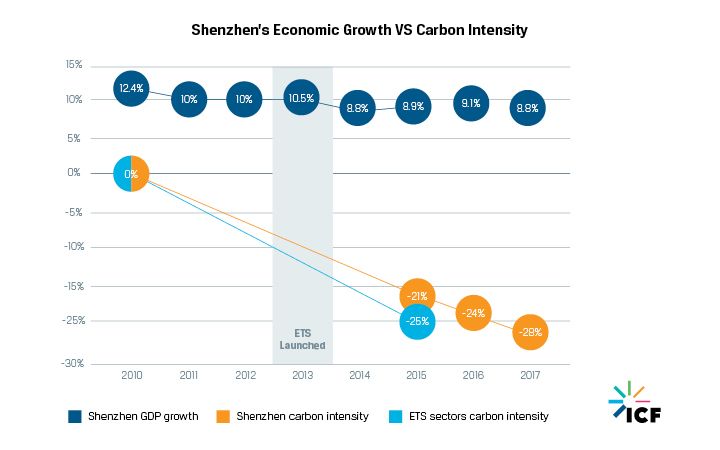
What can other emerging economies learn from China's ETS experience?
As China applies the lessons learned from piloting regional emissions trading systems (ETS) to its national plans, it's worthwhile considering which of these lessons might prove transferable to other emerging economies with large and fast-growing greenhouse gas (GHG) emissions. For India, where policymakers are beginning to consider carbon pricing as part of their emissions reduction toolkit, there is an opportunity to enhance dialogue with China on this front.
1. Aim to reduce carbon emissions and improve air quality simultaneously
China's government has changed its approach to emissions reduction dramatically over the last decade—from being seen as a 'dragger' in the UNFCCC process up to Copenhagen in 2009 to helping secure the 2015 Paris Agreement. Today its leadership on the issue owes much to the slow-down in emissions growth it has enabled by shifts in industrial structure which are both policy and market driven. Importantly, these changes also help realize other co-benefits of climate change mitigation and notably meet public demand for a healthier environment.
The policy context, including a willingness for more action and a proactive role, is also shifting in countries like India, although in different ways. Whereas India has at times been seen as a brake on requiring emission reduction commitments from emerging economies at the UN, the Modi government has placed strong emphasis on the clean energy transition and development of renewable energy. Large-scale solar projects are now reaching historically low contracted prices well ahead of expectations, helping to drive an affordable energy transition. As with China's experience, the Indian government is also facing demands from a burgeoning middle class to deal with the escalating air quality crisis. As a result, policy tools like carbon pricing that have co-benefits for decarbonizing the economy and improving air quality can be considered by policymakers and viewed favorably by the general public.
For Indian policymakers there's a clear opportunity to follow China's path on carbon pricing to maximize the co-benefits of reducing both air pollutants and carbon emissions—and claiming credit for improving people's quality of life and reducing the risk of climate change.
Central to the approach taken by China's government is the use of market-based measures in the form of ETS to provide a price signal for power generation and other energy intensive industries and a cost-effective means of reducing GHG emissions. Various sector-specific and semi-market-based measures are already used in emerging economies, such as the perform, achieve and trade (PAT) energy efficiency scheme in India and the limited carbon tax in Mexico.
China's six years of experience in emissions trading provide an important case study for other emerging economies in Asia and the Americas of how a carbon price with wide coverage can be introduced in a way that is sensitive to the local circumstances of a developing economy while limiting carbon emissions.
2. Take a methodical, coordinated approach to maintain economic growth
China's policymakers learned a valuable lesson early on after setting provincial energy efficiency targets to prompt heavy industries to upgrade their operations. Factories were simply shut down en masse as the deadline for achieving targets approached, causing significant economic disruption. The government subsequently committed to a more gradual, systematic and cost-effective approach—and rolled out seven regional carbon markets. Now that other measures, such as the subsidization of renewable energy and moderation of demand for industrial products, are delivering, the government will increasingly look to carbon pricing as the most effective and efficient tool at its disposal. These lessons can be shared as part of a policy dialogue between China and other major economies.
Existing policies to address CO2 levels in India already provide an implicit carbon price, rather than an explicit one through an ETS. Like China's original targets these industry-specific measures, such as a clean energy tax and excise duties on gasoline and diesel, are failing to deliver efficient progress. A lack of coordination between them means emission reductions are not necessarily achieved at the lowest cost and many efficiency measures are not adequately incentivized.
India can look to China's efforts over the last six years for helpful pointers on how carbon pricing, especially ETS, can help maintain growth while limiting its environmental impact. For example Shenzhen, the first region in China to launch an ETS, has maintained economic growth of around 9 percent per year since the introduction of carbon pricing in 2013. At the same time, the carbon intensity (emissions/output) of the Shenzhen economy has declined rapidly, with the carbon intensity of sectors covered by the ETS falling faster than the economy-wide average.
The Indian government is especially conscious of the potential for cost impacts on consumers. It recently introduced a goods and services tax (GST) and this is still in the process of gaining community acceptance. In addition, the clean energy tax levied on coal has been passed on to consumers in their electricity bill. In this context, adding new costs in the form of carbon pricing may not be viewed positively by power consumers. During the pilot ETS phase, and going into the national system, China has developed a compromise solution in which large electricity consumers, such as industry as well as public and private institutions, are provided with an emissions cap and allowance allocation in the carbon market in relation to their indirect electricity consumption. While the lack of complete cost pass-through means that efficiency incentives are downstream, it does help to protect consumers from the cost impact.
3. Involve vested interests to balance industry concerns with ETS goals
Energy transition inevitably requires producers of energy and industrial products to bear some disruption and costs. While some find ways to move away from fossil fuel- dependent production, others resist change or actively lobby against carbon pricing. Through China's seven regional pilots, the Climate Change department, which is currently within the Ministry of Ecology and Environment, together with key advisers, has prioritized and gained experience in handling the concerns of industry during the policy design process.
They have engaged industry representatives throughout in a number of ways. Companies and sectoral associations sit on committees together with think tanks, government representatives and policy design advisers. ICF together with other local partners has facilitated some of these processes in multiple projects and initiatives through roundtable discussions for industry stakeholders and government advisers. These activities help to draw out opinions on carbon pricing as a way of overcoming the lack of open public debate that takes place in Europe and North America. Some of these workshops provided policy recommendations and feedback loops to policymakers, others enabled exchange of experiences and concerns among market participants and stakeholders. Working with China Carbon Forum, ICF also conducts large-scale surveys of China's carbon pricing stakeholders.
The policymaking environment in India differs in significant ways from China's, where the high concentration of state-owned industry often gives companies a direct line to policymakers. As in many other emerging economies, most industry in India is not state owned and is able to lobby more publicly, potentially influencing public opinion to pressure policymakers on the design of carbon pricing. Still, the principle of balancing the interests of industry and emissions reduction remains the same and, while specifics may vary, emerging economies could benefit from engaging with China about their experience of this process.
4. Factor in existing emissions-reduction measures for optimal ETS design
Every ETS needs to be designed with regard to other measures which may also lead to emissions reduction. Energy efficiency standards, mandatory closure of facilities, pollution mitigation policies and economic slow-down can all impact demand within the carbon market by enabling companies to more easily meet their cap without buying ETS credits. In China, the effects of a range of policies have informed the design of its ETS, in particular the reform of its power sector.
Power sector reform is a prime example of a measure likely to lead to emissions reduction regardless of the ETS. By planning to start operation of its national ETS exclusively in the power sector, the Chinese government has opened up the opportunity to carefully consider how to coordinate these two policies. With help from expert advisers, it is currently looking at how best to calibrate allowance allocation to maintain a carbon price incentive in the ETS in the context of the reform process.
Concerns around consumer impacts in India may mean that with the introduction of an explicit carbon price overlapping policies that risk double-taxing consumers are abolished. While the issues will, again, be different in other emerging economies, China can usefully share its experience of coordinating carbon pricing with other policies and instruments to help ensure the long-term success of its carbon pricing measures including ETS.
In fact, one of the most important lessons any country can learn about ETS design is that dialogue with others that have been there, made mistakes and found creative and feasible solutions can positively impact the process—and the outcome.

